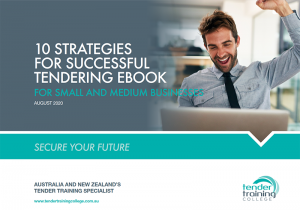Developing a tender price is no easy task. It is an all-encompassing activity that draws upon significant amounts of information, data and costs, and is extremely involved and time consuming.
I’ve helped many organisations to prepare their tender pricing over the last decade. I’ve seen lots of professionals jump in and start preparing the costs without fully comprehending what’s required as part of the tendering process.
The result of this can be costly mistakes, vital information is missed, a lack of robust modelling and/or, you potentially run out of time.
To make tender pricing easier and more efficient, I follow a step-by-step process* which provides for a structured and organised approach. Here are five key steps from that process for developing a competitive and robust tender price.
Step 1: Understand the tender rules and requirements
People have a natural tendency to launch into things on the assumption that they have all the relevant information and they know what the outcome should look like. But that does not work so well most of the time. The same applies when pricing a tender.
Think of what it takes to assemble a piece a flat-packed furniture, e.g. a TV cabinet with cupboards and shelving. While you may be able to assemble it by simply using the picture on the box as the guide, you will find it much easier and quicker if you follow the detailed assembly instructions.
The same applies for tenders. It is really important to read the tender documentation, including the draft contract, any scope of works, and of course, the pricing instructions and financial model (if one is provided). This will give you a thorough understanding of the tender rules and requirements before you begin preparing your bid cost.

Step 2: Develop a program to map out the actions and tasks
Think about the instructions for assembling the flat-packed TV cabinet. That instruction sheet is an ordered mapping of actions and tasks.
Based on what you have learned from the tender document, it is critical that you create your own complementary set of instructions for preparing the tender pricing – i.e. a program. This will help guide you in an organised and methodical fashion from start to finish.
Ideally, your program will identify tasks and actions, and define who is responsible for completing them, as well as a nominated time for completion. This helps keep the team accountable and on track to deliver to the deadline, and to avoid an unpleasant and potentially stressful rush to the finish.
Step 3: Build a robust pricing framework
The final tendered price is the outcome of a significant amount of work of gathering inputs and outputs for the financial/pricing model. The key to developing a competitive and robust price is setting up the framework for the pricing model at the outset.
When developing a framework, you need to think about all the elements of the pricing requirements to be addressed and how these elements will fit neatly together.
It is similar to building a house – which requires consideration of where the kitchen, bedrooms, bathrooms and stairs might be before the house is built. The same applies to building a price model.
If you don’t prepare the pricing framework, it is inevitable that you will miss something and have to spend lots of time to make corrections or re-work later on.

Step 4: Build a robust pricing model
It is hard to sum up in words what it takes to build a great financial pricing model that gives your bid the competitive edge. The following tips cannot possibly do that justice, but they will help make this process a lot more efficient:
- The model should be dynamic – which means it is quick and easy to update, and that multiple inter-related model outputs update simultaneously based on a single change.
- Check and test the model as you build it with dummy numbers – this will allow you to efficiently make changes and corrections as you progress. This avoids substantial time at the end to fix it. Or even worse, the possibility that the team will make an incorrect decision based on that model.
- Use defined formats in the model to clearly separate and highlight sections for cost inputs, distinct from cost outputs. Visually appealing colour codes and shades are also invaluable for this.
Step 5: Approval of the tender price
A tip for developing a winning tender price is to engage with all people in the tender team to ensure you capture their requirements for the price model throughout the bid.
Host pricing workshops to engage the wider team in the development of the price. This way you bring people along the journey and it helps to increase acceptance of the model outputs and results.
Finally, allow sufficient time for the senior executives of your organisation to review the price model in detail. They will need to make an informed strategic decision to approve the tender price in accordance with their overall bid strategy.

*Daniel Rothfield, is a tender pricing specialist and is the principal of Agility Corporate. He has authored the Tender Training College’s new tender pricing course, which provides a step-by-step process to develop a winning bid price.
Check out the new Tender Pricing Fundamentals Certificate for more tips on preparing a winning tender price.






























 There is definitely no “i” in a tender team. And to use another coined phrase: “the whole is greater than the sum of its parts”.
There is definitely no “i” in a tender team. And to use another coined phrase: “the whole is greater than the sum of its parts”. A team without a tender management process is like a rudderless ship.
A team without a tender management process is like a rudderless ship. Every bidder should meet the minimum requirements of the tender, or, what is the point of them bidding?
Every bidder should meet the minimum requirements of the tender, or, what is the point of them bidding?